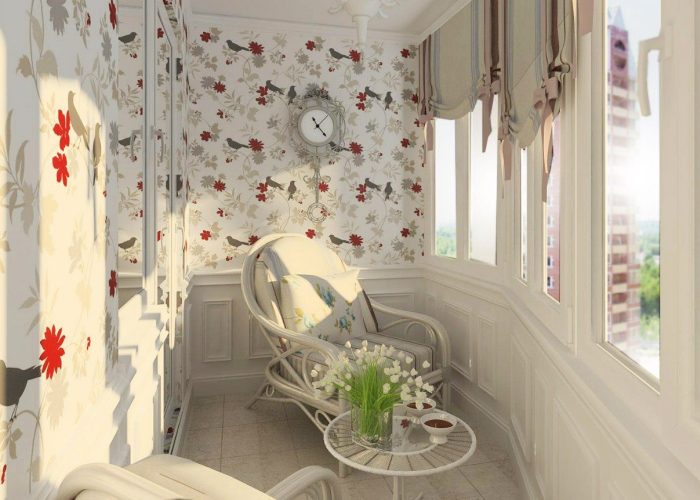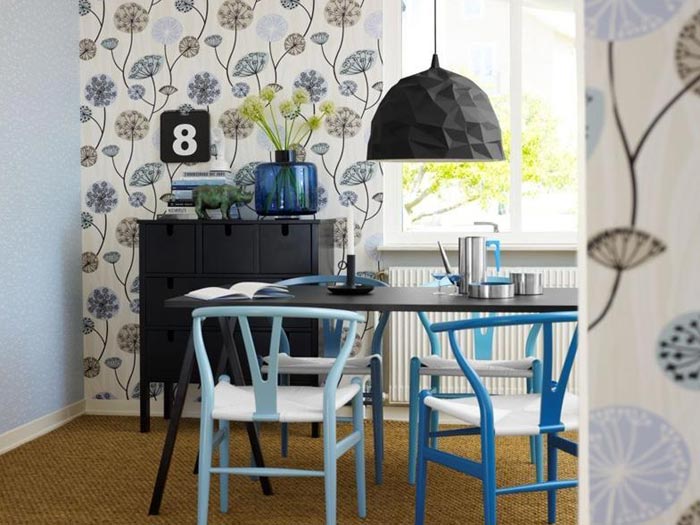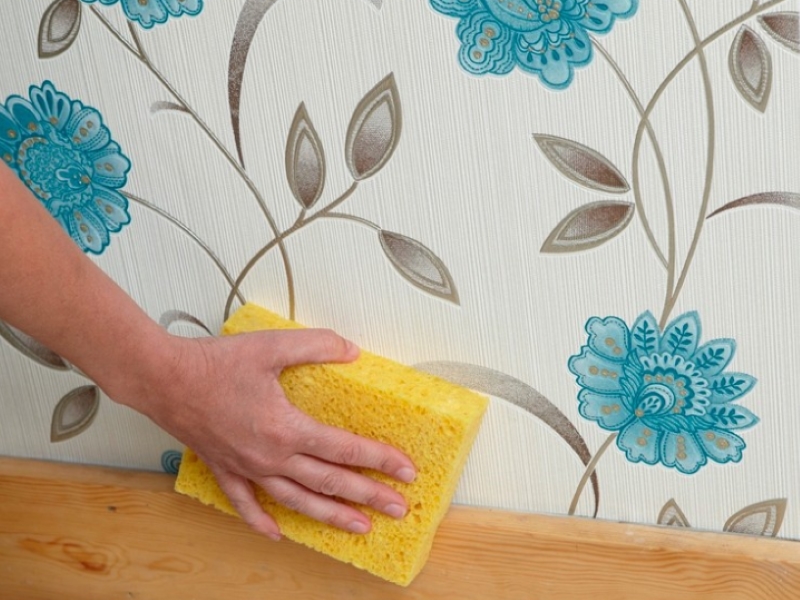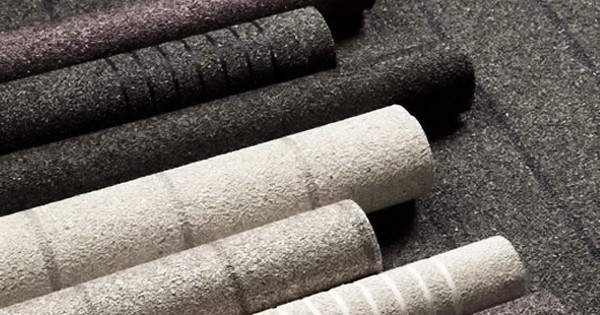Textile wallpaper: characteristics, types, gluing
If among all the wallpapers you need to choose the most comfortable and luxurious, then it is textile, or, as they are also called, textile, that immediately comes to mind. This coating has its own history, because in the days of classicism, baroque and empire the walls in the homes of wealthy people were decorated with fabric. Time passed, now the fabric has been replaced with fabric wallpaper, but this pleasure is still not the cheapest, although affordable for many.
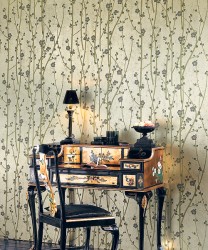 Textile wallpaper fits almost any type of interiorbut look best with upholstered furniture and carpetsmaking the room very cozy. Such wallpapers are made on the basis of fabric or flezilin, but any fabric can be used, including natural and synthetic.
Textile wallpaper fits almost any type of interiorbut look best with upholstered furniture and carpetsmaking the room very cozy. Such wallpapers are made on the basis of fabric or flezilin, but any fabric can be used, including natural and synthetic.
The technology for the production of textile wallpaper is somewhat complicated, so they are made mainly in Europe. First, a textile fabric is prepared, then a base is glued to it, and then all this is dried in chambers with infrared radiation. There is also a technology according to which the threads are attached to the base, rather than a solid web. In any case, when the wallpaper is attached to the wall, the effect of upholstery is obtained.
Advantages and disadvantages
Let's start with the benefits. This is a high aesthetics, which is explained not only by its special surface, but also by the fact that the joints between the canvases of such wallpapers are practically not visible - among all types of wallpapers here they are the least noticeable. You can not discount the naturalness of this material, so the risk of allergies or the accumulation of harmful substances in the apartment is minimized. And since the wallpaper is natural, they breathe, so excessive moisture and mold will never accumulate in the room.
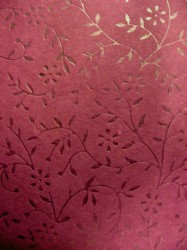 The properties of the fabric themselves determine that the coating is soundproof and heat-insulating, which will save rooms that are not adjacent to others, and also excellent in urban apartments. In addition, some types of wallpaper have other useful properties, for example, linen - have a bactericidal effect. Well, there’s no need to talk about the variety of different colors and patterns - there are a lot of them.
The properties of the fabric themselves determine that the coating is soundproof and heat-insulating, which will save rooms that are not adjacent to others, and also excellent in urban apartments. In addition, some types of wallpaper have other useful properties, for example, linen - have a bactericidal effect. Well, there’s no need to talk about the variety of different colors and patterns - there are a lot of them.
As for the flaws, then immediately it is worth noting the high price. And since this wallpaper is, in fact, a fabric, then they will attract dust, except for linen wallpaper, which is characterized by antistatic impregnation. In addition, the more natural threads in the material, the faster it fades in the sun, and has an uneven color. This wallpaper requires only a dry, very clean cleaning. And one more nuance - when gluing you need to be extremely careful so that the glue does not get on the wallpaper.
Types of textile wallpaper
Depending on which fabric was used in the production of textile wallpaper, several of their classes are distinguished. So, consider the characteristics of the main ones.
Linen wallpaper
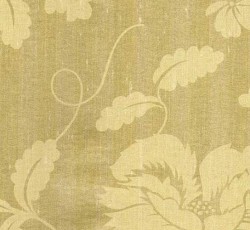 This is a classic option among textile wallpapers, and the most inexpensive. The finished surface is obtained by lamination with blended yarns. The result is a surface with sometimes slightly different shades of thread, but this gives it a natural and effect that the walls are covered with fabric.
This is a classic option among textile wallpapers, and the most inexpensive. The finished surface is obtained by lamination with blended yarns. The result is a surface with sometimes slightly different shades of thread, but this gives it a natural and effect that the walls are covered with fabric.
Linen wallpapers have good operational properties: a high degree of heat and sound insulation, exposure to sunlight, less than others, the ability to attract dust. They are great for children's rooms, classrooms and other rooms with a normal level of humidity.
Silk wallpaper
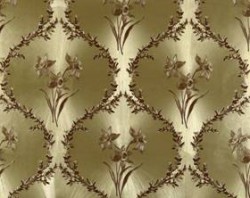 Despite the name, silk in silk wallpaper is only a part, the rest is viscose, which makes it possible to significantly reduce the cost of material. The finished surface is, frankly, luxurious. Such wallpapers are widely used in bedrooms, cabinets, made in the style of Provence or Empire.
Despite the name, silk in silk wallpaper is only a part, the rest is viscose, which makes it possible to significantly reduce the cost of material. The finished surface is, frankly, luxurious. Such wallpapers are widely used in bedrooms, cabinets, made in the style of Provence or Empire.
As for the properties, they all remain the same as the general properties for textile wallpaper.
Jute wallpaper
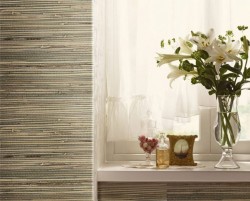 Jute is an Indian plant that is used to make fabric and rope, it is characteristic in appearance, with a wonderful texture. So the wallpapers are obtained with a pronounced texture, and they can easily hide small imperfections of the walls, and some types can also be painted in the desired color.
Jute is an Indian plant that is used to make fabric and rope, it is characteristic in appearance, with a wonderful texture. So the wallpapers are obtained with a pronounced texture, and they can easily hide small imperfections of the walls, and some types can also be painted in the desired color.
Jute wallpapers are not the most demanding and difficult to care for among all textile ones, so they will not cause strong problems. Such material will perfectly complement the interior in style country or ecoIn addition, it does not fade and is notable for good wear resistance.
Felt wallpaper
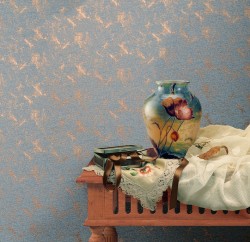 One of the most preferable characteristics of the type of textile wallpaper: they practically do not fade, they retain sound and heat well. They are made by applying felt on a paper base or its synthetic analogue - most often, it is propylene. Of course, if you use non-natural material, the environmental friendliness decreases, but the price becomes more acceptable, and it will also be easier to care for - such wallpapers can even be washed, for example, with a washing vacuum cleaner.
One of the most preferable characteristics of the type of textile wallpaper: they practically do not fade, they retain sound and heat well. They are made by applying felt on a paper base or its synthetic analogue - most often, it is propylene. Of course, if you use non-natural material, the environmental friendliness decreases, but the price becomes more acceptable, and it will also be easier to care for - such wallpapers can even be washed, for example, with a washing vacuum cleaner.
In any case, felt wallpaper looks decent on the wall - the feeling of being tightened up with a single piece of fabric. In general, outwardly felt wallpapers very much resemble velor, but since they strongly collect smells on themselves, they are suitable for rooms that lack them: bedroom, living room, etc.
Velor wallpaper
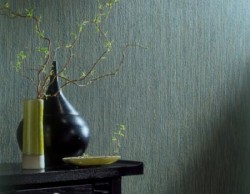 The production of velor wallpaper is one of the most technologically advanced. Here, the paper base is first coated with polyvinyl chloride paint, on which a pattern of special adhesive paint is applied. And until all this has dried, the canvas passes through a special installation that sprays textile particles, and they, due to the electrostatic attraction characteristic of this material, settle on the base in an upright position. Then the resulting fabric is dried and a material is obtained that completely imitates expensive fabrics, resembling a tapestry, velvet, etc.
The production of velor wallpaper is one of the most technologically advanced. Here, the paper base is first coated with polyvinyl chloride paint, on which a pattern of special adhesive paint is applied. And until all this has dried, the canvas passes through a special installation that sprays textile particles, and they, due to the electrostatic attraction characteristic of this material, settle on the base in an upright position. Then the resulting fabric is dried and a material is obtained that completely imitates expensive fabrics, resembling a tapestry, velvet, etc.
The result is a very beautiful and unusual, especially when lighting, coating, which, by the way, does not differ at a particularly low price. The stunning appearance of velor wallpaper, unfortunately, is not supported by equally excellent operational properties: they are very poorly protected from mechanical influences, and caring for them is quite problematic. Therefore, it is better to use them only in the bedroom, and then subject to very careful care, otherwise they will soon lose all their external data.
Synthetic based
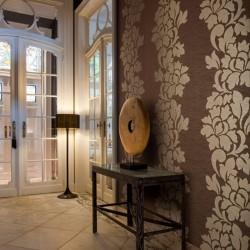 The difference between synthetic-based wallpapers and the others listed above is that paralon is used here as the basis, therefore a high level of sound and heat insulation is provided. In addition, such a material is not only soft to the touch, but also resilient, and at a price much lower than all that have been considered before.
The difference between synthetic-based wallpapers and the others listed above is that paralon is used here as the basis, therefore a high level of sound and heat insulation is provided. In addition, such a material is not only soft to the touch, but also resilient, and at a price much lower than all that have been considered before.
But nevertheless, the main advantage of such wallpapers is that you do not need to thoroughly prepare the surface, because due to their thickness they hide and unevenness, and even some curvature of the walls.
Jacquard wallpaper
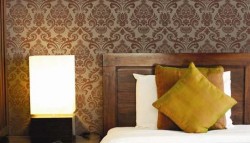 Jacquard wallpaper is a whole class of textile wallpaper, numbering about 250 items.Their height is quite non-standard - about 270 cm, which allows you to literally wrap the entire room in fabric in several steps, and this will reduce the number of seams to a minimum. In addition, in the manufacture of jacquard wallpaper, a special base is used, which does not allow the glue to soak, pass into the layer of wallpaper and spoil the picture.
Jacquard wallpaper is a whole class of textile wallpaper, numbering about 250 items.Their height is quite non-standard - about 270 cm, which allows you to literally wrap the entire room in fabric in several steps, and this will reduce the number of seams to a minimum. In addition, in the manufacture of jacquard wallpaper, a special base is used, which does not allow the glue to soak, pass into the layer of wallpaper and spoil the picture.
Wallpaper "Japanese grass"
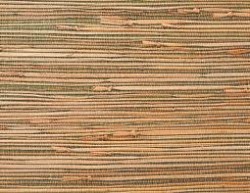 The most unusual textile wallpaper, which is obtained by gluing fiberglass threads on a paper base. Sometimes, instead of fiberglass, sage is used, so the production is quite complicated, the material is expensive, and the circle of its potential buyers is small.
The most unusual textile wallpaper, which is obtained by gluing fiberglass threads on a paper base. Sometimes, instead of fiberglass, sage is used, so the production is quite complicated, the material is expensive, and the circle of its potential buyers is small.
In addition, if in linen wallpaper a slightly different shade can be found in different paintings, then there may be differences in one roll - this is not a defect, but if it is annoying, then you just need to adjust and combine some parts with others.
As for their gluing, it is rather complicated, and in this case it is certainly better to entrust it to specialists, since the canvases are very thin and it is difficult to work with them. By the way, thin canvases will not hide surface imperfections, so it should be perfect.
How to glue textile wallpaper?
The process of gluing textile wallpapers is not so much complicated as painstaking and responsible. Naturally, it’s easier to work if they are not made on paper, but on non-woven base - then they are stronger, and the glue is applied to the wall, so the chances of it getting on the wallpaper itself are not so many. Of course, it would be nice to entrust the whole process to specialists, even if you have some experience in gluing paper wallpapers. But if you still want to try your hand and there is confidence in this, then read on.
Necessary tools
 Wallpaper of a certain type and color;
Wallpaper of a certain type and color;- glue;
- a plumb line and a pencil to mark the lines on the wall to evenly adhere the wallpaper;
- scissors;
- small pile roller for applying glue;
- rubber roller for smoothing the surface.
Surface preparation
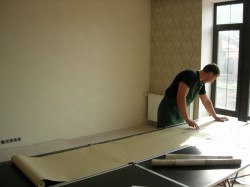 No matter how visually the surface is aligned with certain types of wallpaper, you still need to work on its preparation. Naturally, all traces and residues of past finishing materials are subject to complete removal: paints, plasters, wallpaper, etc. All cracks on the walls must be puttied, and align walls if necessary. It should be noted separately that there should not be any Gossamer net - it can appear through some types of textile wallpaper.
No matter how visually the surface is aligned with certain types of wallpaper, you still need to work on its preparation. Naturally, all traces and residues of past finishing materials are subject to complete removal: paints, plasters, wallpaper, etc. All cracks on the walls must be puttied, and align walls if necessary. It should be noted separately that there should not be any Gossamer net - it can appear through some types of textile wallpaper.
The leveled surface must be primed with a deep penetration primer. Some advise using the same glue that the wallpaper will eventually stick to. After all this, the surface should dry well. It is recommended to paste textile wallpaper at a room temperature of 18-25 degrees, air humidity 40% and surface humidity 8%.
As for glue, then on each packaging of textile wallpaper should be given recommendations on which glue is better to use. But if this is not the case, then you can buy one that is designed for textile or vinyl wallpapers.
Sticking process
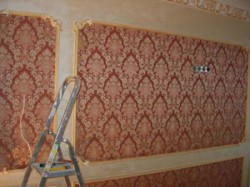 Although the gluing of textile and paper wallpapers has some common features, there are still some features that must be taken into account. Previously, it is better to draw vertical lines on the walls every 1-1.5 meters with a plumb line, so that it is more convenient to navigate. Textile wallpapers are glued always butt, and with a properly conducted process the seams are practically invisible.
Although the gluing of textile and paper wallpapers has some common features, there are still some features that must be taken into account. Previously, it is better to draw vertical lines on the walls every 1-1.5 meters with a plumb line, so that it is more convenient to navigate. Textile wallpapers are glued always butt, and with a properly conducted process the seams are practically invisible.
It is better to cut a roll of textile wallpaper with scissors - the knife is inappropriate here. It is advisable to immediately prepare segments for yourself at least on one wall, attach them in order to check the compatibility of color, texture and pattern, and then number the resulting segments.
If wallpaper on a non-woven basis is selected, then pre-prepared glue is applied only to the surface of the wall, and approximately as much as corresponds to the width of the strip.In this case, the adhesive composition is recommended to be applied with a special roller with a fine pile. If paper wallpapers are chosen, then the glue is recommended to be applied both to them and to the wall, and after applying the glue to the wallpaper, you need to wait and let them drink for 5 minutes, but no more, otherwise they can become sour - this is a very important point.
It is better to start gluing from top to bottom, and smooth it with a hard rubber roller: tools such as plastic spatulas can squeeze out too much glue that can stain the canvas, and the pattern can also be damaged by such a tough tool. Do not use rags or hands to smooth the surface. Moreover, smoothing movements should also be carried out from top to bottom, and not from the center to the edges - this is a feature of textile wallpaper.
In conclusion
Although gluing textile wallpapers is somewhat more complicated, for example, paper ones, the finished effect will definitely please, because it is a very beautiful and unusual coating that will immediately highlight the room and emphasize the taste of the owners. But for the coating to remain beautiful for a long time, you need to regularly look after it. As necessary, the wallpaper is cleaned with a vacuum cleaner, a soft brush or treated with a cloth impregnated with dust absorption. A vacuum cleaner is recommended to be used twice a year.
If a stain has formed on the wall, then while it is fresh, you can try to soak it with a slightly damp cloth, sometimes even with a soapy solution, then dry it with white paper and a hairdryer, but you can’t rub the surface. Old spots are easier to remove by re-gluing a section of wallpaper.

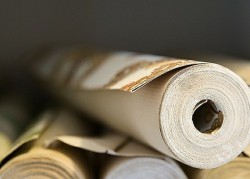 Wallpaper of a certain type and color;
Wallpaper of a certain type and color;
